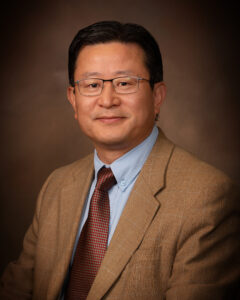 University of Utah materials science and engineering professor Ling Zang was elected to the rank of Fellow to the Council of the American Association for the Advancement of Science (AAAS) for his “distinguished contributions to the research of molecular self-assembly and nanostructures, and development of optical and electrical chemical sensors for applications in public safety, health and environment.”
University of Utah materials science and engineering professor Ling Zang was elected to the rank of Fellow to the Council of the American Association for the Advancement of Science (AAAS) for his “distinguished contributions to the research of molecular self-assembly and nanostructures, and development of optical and electrical chemical sensors for applications in public safety, health and environment.”
Zang along with other newly named Fellows will be inducted during the organization’s Annual Meeting, to be held Feb. 19 in Philadelphia. The AAAS has members in more than 90 countries and is also the publisher of the Science family of research journals.
“I feel honored and humbled to have been elected to this prestigious organization,” Zang said. “I owe many thanks to my previous and current students, postdoctoral researchers, collaborators, and industry partners, who have done all the work that get recognized by AAAS, particularly in the areas of chemical sensors.”
Zang is one of three faculty members from the University of Utah to be named Fellows for 2022. The others are from the School of Biological Sciences and include Professor Dale Clayton, Distinguished Professor Denise Dearing, and Professor Kelly Hughes.
Zang received a bachelor’s degree in physical chemistry in 1991 from Tsinghua University in Beijing and a doctorate in chemistry in 1995 from the Chinese Academy of Sciences. His first job in academia was as an assistant professor at Southern Illinois University in 2003. He arrived at the U as an associate professor in the Department of Materials Science and Engineering in 2008 and was named a full professor in 2013.
He was previously an Alexander von Humboldt Fellow and in 2007 received the National Science Foundation’s Faculty Early Career Development Program (CAREER) Award. He was also named a Fellow of the National Academy of Inventors in 2020.
In addition to nanomaterials and chemical sensors, Zang’s research also focuses on organic semiconductors and nanostructures, optoelectronic nanodevices, and photocatalysis and photovoltaics for conversion of solar energy. His research discoveries have been applied to areas of defense, public safety, renewable energy and environmental protection. He is the founder of two companies, Vaporsens and Metallosensors.
Many of his patented sensor technologies have been developed for products such as a handheld device that can quickly detect explosives and airborne chemicals and another that can identify heavy metal pollutants in water. He is also involved in the development of new technology that combines molecular sensors and chromatography that will enable fieldable, high throughput monitoring of water quality and diseases. He currently has 30 patents that were either granted or are pending, about half of which have been licensed to industry, and has more than 140 papers published in peer-reviewed journals in chemistry, materials science, sensors, and nanotechnology.
Each year, the AAAS Council elects members whose “efforts on behalf of the advancement of science, or its applications, are scientifically or socially distinguished.”